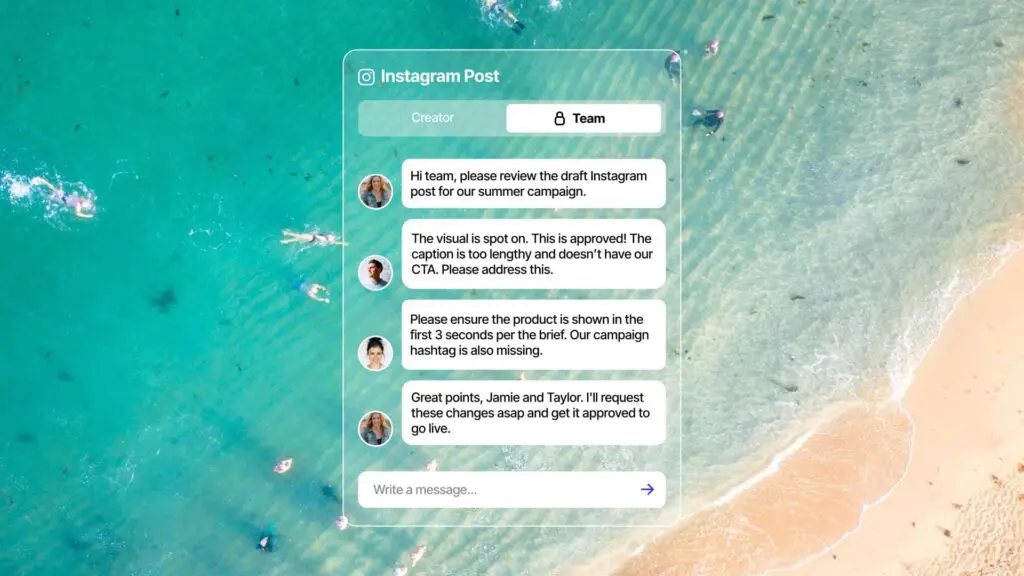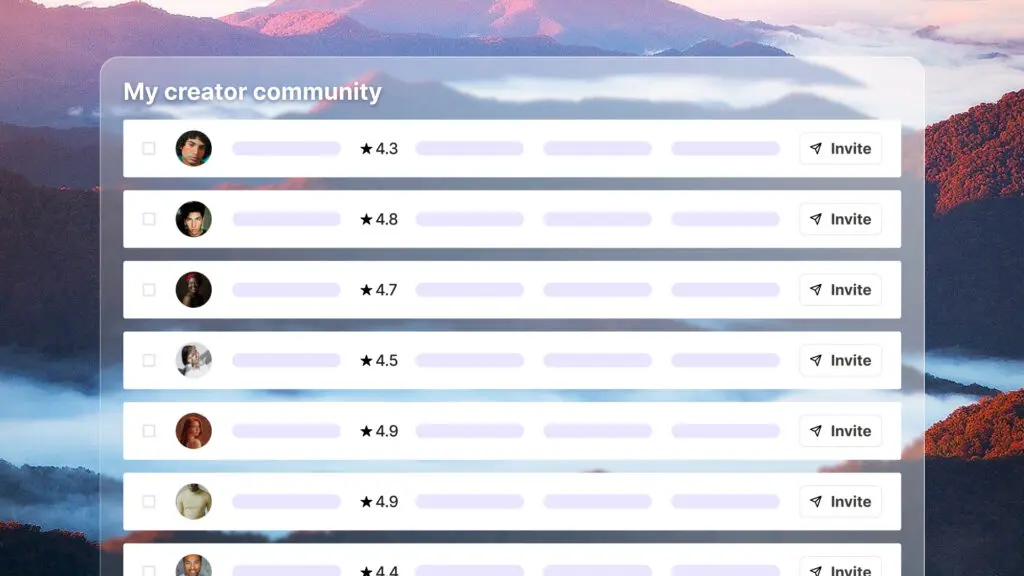

They have different approaches when it comes to content creation and brand promotion, and it’s important for marketing and communication strategists to understand the difference from the outset.
When you know what the differences are, then you can really fine tune your marketing strategy. So in this post, we delve into the things that set influencers and creators apart by exploring their characteristics and offer insights into how brands can collaborate with both creators and influencers to maximise marketing efforts.
Creators craft content across various digital platforms, including social media, blogs, websites, and more. They produce content that aligns with their niche interests, passions, and expertise.
As the name suggests, creators create content, such as articles, videos, music, and visuals, which are then shared with their audience and readers. Unlike influencers, creators prioritise the creation of content over generating masses of followers, so their content reflects their artistic vision and passion for their subject matter.
TikTok’s Coach RAC is a perfect example. He uses his love of baseball to educate and entertain his readers, and he has a genuine dedication to creating valuable content. This shines through his posts and platforms, and it reflects an authentic commitment to his niche.

Influencers are social media personalities who shape their followers’ decisions and actions through their personal brand. They share their daily lives and experiences, and endorse products and services that resonate with their audiences.
The content provided by influencers aims to inspire followers, getting them to engage with brands and products that the influencer endorses. Their followers trust their recommendations, so influencers are an invaluable bridge between brands and potential customers.
You can also get microinfluencers. These are influencers with smaller audiences, who focus on a very specific niche. They’re highly engaged and love their chosen topic. They’re authentic and gritty, and working with them can be a very powerful way of building brand traction.
Jackson Olsen is an example of a successful TikTok influencer within the baseball community. He blends engaging content with lifestyle, sports, and branded content to create an authentic connection with his audience.
He subtly promotes brands like Savannah Bananas and Major League Baseball, and his influence underscores the value of influencer-driven marketing. His promotion of these brands has gained them traction with his followers and they’re now synonymous with his brand.
Before we dig into the differences, it’s important to know the similarities between the two. Both influencers and creators create user-generated content (UGC), which is essentially any content created and shared by customers and individuals rather than by brands themselves. You can find out more about UGC, and how it can benefit your brand and campaigns, in our in-depth blog post.
Creators prioritise the creation of valuable content. Influencers focus on building a personal brand that inspires and influences followers’ purchasing decisions.
Creators believe in high-quality creative content that engages their followers on a creative level. Influencers incorporate brand endorsements within their content to promote products and services.
Creators engage deeply with their followers and foster strong connections. Influencers aim to reach a wider audience and drive action through their recommendations.

Considering the differences between a creator and an influencer, the reasons why you’d engage with them will differ depending on what you want to achieve. Each one offers distinct benefits to brands and enhances their marketing strategies in unique ways.
Quality content creators prioritise just that – quality. This means that everything they create resonates with their audience and reflects their creative vision. They bring a deep niche expertise to their social media platforms, and this makes them the ideal partners for brands looking for legitimacy and authenticity.
Creators also have dedicated followers that trust their recommendations, which leads to higher conversion rates for the products and services they endorse.
Influencers provide you with an opportunity to increase brand awareness and to reach a broader audience, so you can extend your brand visibility beyond your current market. They also have followers from diverse demographics, so your brand can connect with audiences that you may not have otherwise been able to.
Influencers have a personal brand, which encourages engaging interactions with their followers and often leads to impressive conversion rates.
There is no reason why your brand should choose between a creator and an influencer. You can leverage the strengths of both to enhance your marketing efforts.
When you collaborate with creators, you can develop valuable evergreen content that aligns with your brand values, educates consumers, and establishes brand authority. Influencers, on the other hand, can amplify your brand reach and introduce your product to new audiences while fostering a sense of trust and authenticity.

When you work with creators, it’s important to find those who share your brand values and who genuinely like your brand. This will forge a relationship of trust and will allow both you and your chosen creator to deliver content that’s authentic and relevant to their followers.
You need to trust in your creators when it comes to how they serve the content and how they present your brand (without compromising on your brand identity) as they know their audiences and how best to speak with them.
Thanks to their commitment to their markets and their niches, creators are growing in popularity as they have a creative vision and their online presence is relatable and authentic. Creators are generally not presenting unattainable lifestyles to their audiences – they’re grounded and their lives are achievable – so don’t equate huge followers with success, rather look at how engaged their followers are and take it from there.
It can be tough for organizations to relinquish creative control to a creator, especially if the creator is using different emotions, such as humor or vulnerability, to communicate the brand’s message. However, it is possible to find a balance between your brand style and the creator’s approach.
Influencers often have a different approach to creators. Ranging from high-end celebrities to accounts followed by millions, influencers do what their name says – influence people. Their endorsements and lifestyles attract followers and make the brands they recommend appear desirable and high profile.
Influencers now also have different follower bases, with microinfluencers and nano influencers often having followers in the thousands instead of the millions, but these followers are usually loyal, and they’re passionate about the lifestyle that the influencer portrays. Influencers generally expect a decent fee, but they work with brands to create campaigns that align closely with brand identity and expectations.

In the dynamic world of influencer marketing, it’s important to understand the difference between the creator and the influencer when creating effective marketing strategies.
Your creators are there to prioritise the creation of content as an art form. Your influencers are there to use their personal brand to inspire action.
When you harness the expertise of creators and the reach of influencers, you can create a potent marketing cocktail that resonates deeply with your target market and has a measurable impact on your brand’s growth.
Using your understanding of these two roles, you can navigate the influencer landscape confidently and transform your marketing campaigns. You’ll soon recognise each one’s different strengths, so you can manage your approaches and fine tune your marketing to get the best possible results.
There are hundreds of thousands of creators and influencers out there, so finding the ones that really resonate with your target audience can be tricky. However, using a platform like Vamp makes the process considerably simpler, and means you can manage and track your influencer and creator marketing campaigns with ease.
Discover how Vamp can transform your creator and influencer campaigns



| Cookie | Duration | Description |
|---|---|---|
| __cf_bm | 30 minutes | This cookie, set by Cloudflare, is used to support Cloudflare Bot Management. |
| _abck | 1 year | This cookie is used to detect and defend when a client attempt to replay a cookie.This cookie manages the interaction with online bots and takes the appropriate actions. |
| _GRECAPTCHA | 5 months 27 days | This cookie is set by the Google recaptcha service to identify bots to protect the website against malicious spam attacks. |
| bm_sz | 4 hours | This cookie is set by the provider Akamai Bot Manager. This cookie is used to manage the interaction with the online bots. It also helps in fraud preventions |
| cookielawinfo-checkbox-advertisement | 1 year | Set by the GDPR Cookie Consent plugin, this cookie is used to record the user consent for the cookies in the "Advertisement" category . |
| cookielawinfo-checkbox-analytics | 11 months | This cookie is set by GDPR Cookie Consent plugin. The cookie is used to store the user consent for the cookies in the category "Analytics". |
| cookielawinfo-checkbox-functional | 11 months | The cookie is set by GDPR cookie consent to record the user consent for the cookies in the category "Functional". |
| cookielawinfo-checkbox-necessary | 11 months | This cookie is set by GDPR Cookie Consent plugin. The cookies is used to store the user consent for the cookies in the category "Necessary". |
| cookielawinfo-checkbox-others | 11 months | This cookie is set by GDPR Cookie Consent plugin. The cookie is used to store the user consent for the cookies in the category "Other. |
| cookielawinfo-checkbox-performance | 11 months | This cookie is set by GDPR Cookie Consent plugin. The cookie is used to store the user consent for the cookies in the category "Performance". |
| CookieLawInfoConsent | 1 year | Records the default button state of the corresponding category & the status of CCPA. It works only in coordination with the primary cookie. |
| csrftoken | past | This cookie is associated with Django web development platform for python. Used to help protect the website against Cross-Site Request Forgery attacks |
| elementor | never | This cookie is used by the website's WordPress theme. It allows the website owner to implement or change the website's content in real-time. |
| viewed_cookie_policy | 11 months | The cookie is set by the GDPR Cookie Consent plugin and is used to store whether or not user has consented to the use of cookies. It does not store any personal data. |
| Cookie | Duration | Description |
|---|---|---|
| __hssc | 30 minutes | HubSpot sets this cookie to keep track of sessions and to determine if HubSpot should increment the session number and timestamps in the __hstc cookie. |
| __hssrc | session | This cookie is set by Hubspot whenever it changes the session cookie. The __hssrc cookie set to 1 indicates that the user has restarted the browser, and if the cookie does not exist, it is assumed to be a new session. |
| __hstc | 5 months 27 days | This is the main cookie set by Hubspot, for tracking visitors. It contains the domain, initial timestamp (first visit), last timestamp (last visit), current timestamp (this visit), and session number (increments for each subsequent session). |
| _ga | 2 years | The _ga cookie, installed by Google Analytics, calculates visitor, session and campaign data and also keeps track of site usage for the site's analytics report. The cookie stores information anonymously and assigns a randomly generated number to recognize unique visitors. |
| _ga_56JWQ0019V | 2 years | This cookie is installed by Google Analytics. |
| _gat_UA-132076027-1 | 1 minute | A variation of the _gat cookie set by Google Analytics and Google Tag Manager to allow website owners to track visitor behaviour and measure site performance. The pattern element in the name contains the unique identity number of the account or website it relates to. |
| _gcl_au | 3 months | Provided by Google Tag Manager to experiment advertisement efficiency of websites using their services. |
| _gid | 1 day | Installed by Google Analytics, _gid cookie stores information on how visitors use a website, while also creating an analytics report of the website's performance. Some of the data that are collected include the number of visitors, their source, and the pages they visit anonymously. |
| bscookie | 1 year | LinkedIn sets this cookie to store performed actions on the website. |
| CONSENT | 2 years | YouTube sets this cookie via embedded youtube-videos and registers anonymous statistical data. |
| hubspotutk | 5 months 27 days | HubSpot sets this cookie to keep track of the visitors to the website. This cookie is passed to HubSpot on form submission and used when deduplicating contacts. |
| Cookie | Duration | Description |
|---|---|---|
| _fbp | 3 months | This cookie is set by Facebook to display advertisements when either on Facebook or on a digital platform powered by Facebook advertising, after visiting the website. |
| _pin_unauth | 1 year | This cookie is placed by Pinterest Tag when the user cannot be matched. It contains a unique UUID to group actions across pages. |
| AnalyticsSyncHistory | 1 month | No description |
| bcookie | 1 year | LinkedIn sets this cookie from LinkedIn share buttons and ad tags to recognize browser ID. |
| bscookie | 1 year | LinkedIn sets this cookie to store performed actions on the website. |
| fr | 3 months | Facebook sets this cookie to show relevant advertisements to users by tracking user behaviour across the web, on sites that have Facebook pixel or Facebook social plugin. |
| IDE | 1 year 24 days | Google DoubleClick IDE cookies are used to store information about how the user uses the website to present them with relevant ads and according to the user profile. |
| lang | session | LinkedIn sets this cookie to remember a user's language setting. |
| lidc | 1 day | LinkedIn sets the lidc cookie to facilitate data center selection. |
| MONITOR_WEB_ID | 3 months | The cookie is used by: TikTok The functionality is: to store if the user has seen embedded content. The purpose is: Marketing/Tracking |
| test_cookie | 15 minutes | The test_cookie is set by doubleclick.net and is used to determine if the user's browser supports cookies. |
| ttwid | 1 year | No description available. |
| UserMatchHistory | 1 month | LinkedIn sets this cookie for LinkedIn Ads ID syncing. |
| VISITOR_INFO1_LIVE | 5 months 27 days | A cookie set by YouTube to measure bandwidth that determines whether the user gets the new or old player interface. |
| YSC | session | YSC cookie is set by Youtube and is used to track the views of embedded videos on Youtube pages. |
| yt-remote-connected-devices | never | YouTube sets this cookie to store the video preferences of the user using embedded YouTube video. |
| yt-remote-device-id | never | YouTube sets this cookie to store the video preferences of the user using embedded YouTube video. |
| yt.innertube::nextId | never | This cookie, set by YouTube, registers a unique ID to store data on what videos from YouTube the user has seen. |
| yt.innertube::requests | never | This cookie, set by YouTube, registers a unique ID to store data on what videos from YouTube the user has seen. |
| Cookie | Duration | Description |
|---|---|---|
| li_gc | 5 months 27 days | No description |
| ln_or | 1 day | No description |
| msToken | 10 days | No description |
| wp-wpml_current_language | session | No description available. |